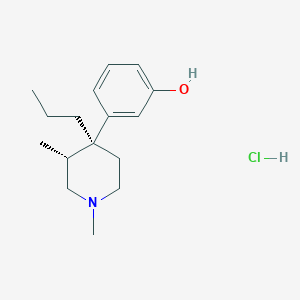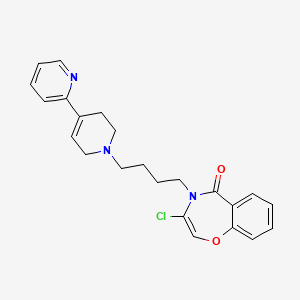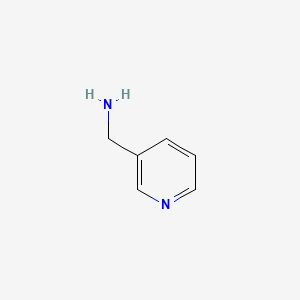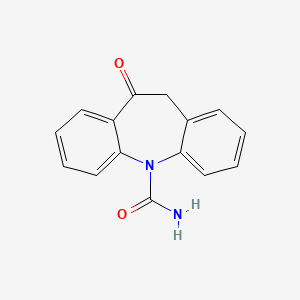
奥卡西平
概述
描述
奥卡西平是一种主要用于治疗癫痫的药物。它是卡马西平的结构衍生物,以其抗惊厥特性而闻名。奥卡西平在市场上以多种品牌名称销售,包括 Trileptal 和 Oxtellar XR。 它用于控制成人和儿童的局灶性癫痫发作 .
作用机制
奥卡西平及其活性代谢物 MHD 通过阻断电压敏感的钠通道发挥作用。这种作用稳定过度兴奋的神经膜,抑制神经元重复放电,并减少突触脉冲的传播。 这些机制对于预防癫痫发作的传播至关重要 .
类似化合物:
卡马西平: 奥卡西平的母体化合物。
艾司卡巴替尔: 另一种具有类似抗惊厥特性的衍生物。
拉莫三嗪: 一种具有不同化学结构但具有类似治疗用途的抗惊厥药 .
比较:
奥卡西平与卡马西平: 与卡马西平相比,奥卡西平的副作用更少,药物相互作用更少.
奥卡西平与艾司卡巴替尔: 两者具有类似的作用机制,但艾司卡巴替尔被用作前药,其药代动力学可能得到改善.
奥卡西平与拉莫三嗪: 虽然两者都用于治疗癫痫,但拉莫三嗪也用于治疗双相情感障碍,其作用机制不同,涉及抑制谷氨酸释放.
科学研究应用
奥卡西平在科学研究中具有广泛的应用:
化学: 用作研究氧化和还原反应的模型化合物。
生物学: 研究其对神经元活动和神经递质释放的影响。
医学: 广泛研究其抗惊厥特性及其在治疗双相情感障碍中的潜在用途。
工业: 用于开发新的药物制剂和药物递送系统 .
生化分析
Biochemical Properties
Oxcarbazepine exerts its effects by interacting with various biomolecules in the body. The primary biochemical property of oxcarbazepine is its ability to inhibit voltage-gated sodium channels, which are essential for the propagation of action potentials in neurons. By blocking these channels, oxcarbazepine reduces the abnormal electrical activity in the brain that leads to seizures . Additionally, oxcarbazepine undergoes rapid and extensive metabolism to its active metabolite, 10-hydroxycarbazepine, through the action of cytosolic arylketone reductase .
Cellular Effects
Oxcarbazepine has significant effects on various types of cells and cellular processes. In neurons, oxcarbazepine inhibits the excessive firing of action potentials by blocking voltage-gated sodium channels. This action stabilizes hyperexcited neural membranes and reduces the frequency of seizures . Oxcarbazepine also influences cell signaling pathways, gene expression, and cellular metabolism. It has been shown to modulate the release of neurotransmitters, thereby affecting synaptic transmission and neuronal communication .
Molecular Mechanism
The molecular mechanism of oxcarbazepine involves its interaction with voltage-gated sodium channels. By binding to these channels, oxcarbazepine prevents the influx of sodium ions, which is necessary for the initiation and propagation of action potentials in neurons . This blockade of sodium channels reduces neuronal excitability and prevents the spread of abnormal electrical activity in the brain. Additionally, oxcarbazepine’s active metabolite, 10-hydroxycarbazepine, contributes to its anticonvulsant effects by further inhibiting sodium channels .
Temporal Effects in Laboratory Settings
In laboratory settings, the effects of oxcarbazepine have been studied over time to understand its stability, degradation, and long-term impact on cellular function. Oxcarbazepine is rapidly absorbed and metabolized to 10-hydroxycarbazepine, which has a longer half-life and provides sustained anticonvulsant effects . Studies have shown that oxcarbazepine maintains its efficacy over extended periods, with minimal degradation . Long-term treatment with oxcarbazepine has been associated with stable seizure control and minimal adverse effects on cellular function .
Dosage Effects in Animal Models
The effects of oxcarbazepine vary with different dosages in animal models. At therapeutic doses, oxcarbazepine effectively reduces seizure frequency without causing significant adverse effects . At higher doses, oxcarbazepine can lead to toxic effects, including sedation, ataxia, and hepatotoxicity . Animal studies have also shown that chronic administration of oxcarbazepine can result in the development of tolerance, necessitating dose adjustments to maintain its anticonvulsant efficacy .
Metabolic Pathways
Oxcarbazepine is primarily metabolized in the liver through the action of cytosolic arylketone reductase, which converts it to its active metabolite, 10-hydroxycarbazepine . This metabolite is further metabolized through glucuronidation and hydroxylation pathways . The metabolic pathways of oxcarbazepine are distinct from those of carbamazepine, resulting in reduced drug-drug interactions and a more favorable safety profile .
Transport and Distribution
After oral administration, oxcarbazepine is rapidly absorbed and distributed throughout the body . Its active metabolite, 10-hydroxycarbazepine, has a volume of distribution of 0.75 L/kg and is extensively bound to plasma proteins . Oxcarbazepine and its metabolites are primarily excreted through the kidneys . The transport and distribution of oxcarbazepine within cells and tissues are influenced by its interactions with transporters and binding proteins .
Subcellular Localization
Oxcarbazepine and its active metabolite, 10-hydroxycarbazepine, are localized within the cytosol of cells . The subcellular localization of oxcarbazepine is crucial for its activity, as it allows the compound to interact with voltage-gated sodium channels and exert its anticonvulsant effects . The targeting of oxcarbazepine to specific cellular compartments is facilitated by its chemical structure and post-translational modifications .
准备方法
合成路线和反应条件: 奥卡西平由卡马西平通过化学反应合成,该反应涉及卡马西平分子的氧化。该过程通常涉及使用氧化剂,例如过氧化氢或过酸。 反应条件包括控制温度和 pH 值,以确保卡马西平选择性氧化为奥卡西平 .
工业生产方法: 在工业环境中,奥卡西平的生产涉及使用类似氧化剂的大规模氧化反应。 该过程针对高产率和纯度进行了优化,通常涉及多个纯化步骤,例如重结晶和色谱法,以去除杂质和副产物 .
化学反应分析
反应类型: 奥卡西平会发生各种化学反应,包括:
氧化: 奥卡西平转化为其活性代谢物,10,11-二氢-10-羟基卡马西平 (MHD)。
还原: 还原反应可以将奥卡西平还原为其前体形式。
取代: 取代反应可以在酰胺或芳香位置发生
常用试剂和条件:
氧化剂: 过氧化氢,过酸。
还原剂: 硼氢化钠,氢化铝锂。
取代试剂: 卤素,烷基化剂
主要产品:
10,11-二氢-10-羟基卡马西平 (MHD): 主要的活性代谢物。
各种取代衍生物: 取决于取代反应中使用的试剂
相似化合物的比较
Carbamazepine: The parent compound from which oxcarbazepine is derived.
Eslicarbazepine: Another derivative with similar anticonvulsant properties.
Lamotrigine: An anticonvulsant with a different chemical structure but similar therapeutic uses .
Comparison:
Oxcarbazepine vs. Carbamazepine: Oxcarbazepine has a better side effect profile and fewer drug interactions compared to carbamazepine.
Oxcarbazepine vs. Eslicarbazepine: Both have similar mechanisms of action, but eslicarbazepine is marketed as a prodrug with potentially improved pharmacokinetics.
Oxcarbazepine vs. Lamotrigine: While both are used to treat epilepsy, lamotrigine is also used for bipolar disorder and has a different mechanism of action involving the inhibition of glutamate release.
Oxcarbazepine stands out due to its reduced propensity for drug-drug interactions and its effectiveness in managing partial-onset seizures with a relatively favorable side effect profile .
属性
IUPAC Name |
5-oxo-6H-benzo[b][1]benzazepine-11-carboxamide | |
|---|---|---|
| Source | PubChem | |
| URL | https://pubchem.ncbi.nlm.nih.gov | |
| Description | Data deposited in or computed by PubChem | |
InChI |
InChI=1S/C15H12N2O2/c16-15(19)17-12-7-3-1-5-10(12)9-14(18)11-6-2-4-8-13(11)17/h1-8H,9H2,(H2,16,19) | |
| Source | PubChem | |
| URL | https://pubchem.ncbi.nlm.nih.gov | |
| Description | Data deposited in or computed by PubChem | |
InChI Key |
CTRLABGOLIVAIY-UHFFFAOYSA-N | |
| Source | PubChem | |
| URL | https://pubchem.ncbi.nlm.nih.gov | |
| Description | Data deposited in or computed by PubChem | |
Canonical SMILES |
C1C2=CC=CC=C2N(C3=CC=CC=C3C1=O)C(=O)N | |
| Source | PubChem | |
| URL | https://pubchem.ncbi.nlm.nih.gov | |
| Description | Data deposited in or computed by PubChem | |
Molecular Formula |
C15H12N2O2 | |
| Source | PubChem | |
| URL | https://pubchem.ncbi.nlm.nih.gov | |
| Description | Data deposited in or computed by PubChem | |
DSSTOX Substance ID |
DTXSID0045703 | |
| Record name | Oxcarbazepine | |
| Source | EPA DSSTox | |
| URL | https://comptox.epa.gov/dashboard/DTXSID0045703 | |
| Description | DSSTox provides a high quality public chemistry resource for supporting improved predictive toxicology. | |
Molecular Weight |
252.27 g/mol | |
| Source | PubChem | |
| URL | https://pubchem.ncbi.nlm.nih.gov | |
| Description | Data deposited in or computed by PubChem | |
Physical Description |
Solid | |
| Record name | Oxcarbazepine | |
| Source | Human Metabolome Database (HMDB) | |
| URL | http://www.hmdb.ca/metabolites/HMDB0014914 | |
| Description | The Human Metabolome Database (HMDB) is a freely available electronic database containing detailed information about small molecule metabolites found in the human body. | |
| Explanation | HMDB is offered to the public as a freely available resource. Use and re-distribution of the data, in whole or in part, for commercial purposes requires explicit permission of the authors and explicit acknowledgment of the source material (HMDB) and the original publication (see the HMDB citing page). We ask that users who download significant portions of the database cite the HMDB paper in any resulting publications. | |
Solubility |
Slightly soluble in chloroform, dichloromethane, acetone, and methanol and practically insoluble in ethanol, ether, and water., 1.60e-01 g/L | |
| Record name | OXCARBAZEPINE | |
| Source | Hazardous Substances Data Bank (HSDB) | |
| URL | https://pubchem.ncbi.nlm.nih.gov/source/hsdb/7524 | |
| Description | The Hazardous Substances Data Bank (HSDB) is a toxicology database that focuses on the toxicology of potentially hazardous chemicals. It provides information on human exposure, industrial hygiene, emergency handling procedures, environmental fate, regulatory requirements, nanomaterials, and related areas. The information in HSDB has been assessed by a Scientific Review Panel. | |
| Record name | Oxcarbazepine | |
| Source | Human Metabolome Database (HMDB) | |
| URL | http://www.hmdb.ca/metabolites/HMDB0014914 | |
| Description | The Human Metabolome Database (HMDB) is a freely available electronic database containing detailed information about small molecule metabolites found in the human body. | |
| Explanation | HMDB is offered to the public as a freely available resource. Use and re-distribution of the data, in whole or in part, for commercial purposes requires explicit permission of the authors and explicit acknowledgment of the source material (HMDB) and the original publication (see the HMDB citing page). We ask that users who download significant portions of the database cite the HMDB paper in any resulting publications. | |
Mechanism of Action |
The exact mechanism through which oxcarbazepine and its active metaoblite, MHD, exert their anti-epileptic effects is unclear, but is thought to primarily involve the blockade of voltage-gated sodium channels. The opening and closing of sodium channels allows for the propagation of action potentials along neurons - in epilepsy, these action potentials can occur in excess of that required for normal function, and the repetitive and pathological firing of these action potentials leads to seizure activity. Both oxcarbazepine and MHD are thought to inhibit seizure activity by binding to the inactive state of voltage-gated sodium channels, thus prolonging the period in which the receptor is unavailable for action potential propagation. This helps to stabilize hyperexcited neuronal membranes, inhibit repetitive neuron firing, and prevent the spread of seizure activity within the CNS without affecting normal neuronal transmission. Increased potassium conductance and modulation of voltage-activated calcium channels is also thought to play a role in the anti-seizure activity of oxcarbazepine. Inhibition of glutamatergic activity was thought to contribute to oxcarbazepine's activity, but this effect could not be replicated _in vivo_., The pharmacological activity of Trileptal (oxcarbazepine) is primarily exerted through the 10-monohydroxy metabolite (MHD) of oxcarbazepine. The precise mechanism by which oxcarbazepine and MHD exert their antiseizure effect is unknown; however, in vitro electrophysiological studies indicate that they produce blockade of voltage-sensitive sodium channels, resulting in stabilization of hyperexcited neural membranes, inhibition of repetitive neuronal firing, and diminution of propagation of synaptic impulses. These actions are thought to be important in the prevention of seizure spread in the intact brain. In addition, increased potassium conductance and modulation of high-voltage activated calcium channels may contribute to the anticonvulsant effects of the drug. No significant interactions of oxcarbazepine or MHD with brain neurotransmitter or modulator receptor sites have been demonstrated. | |
| Record name | Oxcarbazepine | |
| Source | DrugBank | |
| URL | https://www.drugbank.ca/drugs/DB00776 | |
| Description | The DrugBank database is a unique bioinformatics and cheminformatics resource that combines detailed drug (i.e. chemical, pharmacological and pharmaceutical) data with comprehensive drug target (i.e. sequence, structure, and pathway) information. | |
| Explanation | Creative Common's Attribution-NonCommercial 4.0 International License (http://creativecommons.org/licenses/by-nc/4.0/legalcode) | |
| Record name | OXCARBAZEPINE | |
| Source | Hazardous Substances Data Bank (HSDB) | |
| URL | https://pubchem.ncbi.nlm.nih.gov/source/hsdb/7524 | |
| Description | The Hazardous Substances Data Bank (HSDB) is a toxicology database that focuses on the toxicology of potentially hazardous chemicals. It provides information on human exposure, industrial hygiene, emergency handling procedures, environmental fate, regulatory requirements, nanomaterials, and related areas. The information in HSDB has been assessed by a Scientific Review Panel. | |
Color/Form |
Crystals from ethanol, White to faintly orange crystalline powder | |
CAS No. |
28721-07-5 | |
| Record name | Oxcarbazepine | |
| Source | CAS Common Chemistry | |
| URL | https://commonchemistry.cas.org/detail?cas_rn=28721-07-5 | |
| Description | CAS Common Chemistry is an open community resource for accessing chemical information. Nearly 500,000 chemical substances from CAS REGISTRY cover areas of community interest, including common and frequently regulated chemicals, and those relevant to high school and undergraduate chemistry classes. This chemical information, curated by our expert scientists, is provided in alignment with our mission as a division of the American Chemical Society. | |
| Explanation | The data from CAS Common Chemistry is provided under a CC-BY-NC 4.0 license, unless otherwise stated. | |
| Record name | Oxcarbazepine [USAN:USP:INN:BAN] | |
| Source | ChemIDplus | |
| URL | https://pubchem.ncbi.nlm.nih.gov/substance/?source=chemidplus&sourceid=0028721075 | |
| Description | ChemIDplus is a free, web search system that provides access to the structure and nomenclature authority files used for the identification of chemical substances cited in National Library of Medicine (NLM) databases, including the TOXNET system. | |
| Record name | Oxcarbazepine | |
| Source | DrugBank | |
| URL | https://www.drugbank.ca/drugs/DB00776 | |
| Description | The DrugBank database is a unique bioinformatics and cheminformatics resource that combines detailed drug (i.e. chemical, pharmacological and pharmaceutical) data with comprehensive drug target (i.e. sequence, structure, and pathway) information. | |
| Explanation | Creative Common's Attribution-NonCommercial 4.0 International License (http://creativecommons.org/licenses/by-nc/4.0/legalcode) | |
| Record name | OXCARBAZEPINE | |
| Source | DTP/NCI | |
| URL | https://dtp.cancer.gov/dtpstandard/servlet/dwindex?searchtype=NSC&outputformat=html&searchlist=758693 | |
| Description | The NCI Development Therapeutics Program (DTP) provides services and resources to the academic and private-sector research communities worldwide to facilitate the discovery and development of new cancer therapeutic agents. | |
| Explanation | Unless otherwise indicated, all text within NCI products is free of copyright and may be reused without our permission. Credit the National Cancer Institute as the source. | |
| Record name | Oxcarbazepine | |
| Source | EPA DSSTox | |
| URL | https://comptox.epa.gov/dashboard/DTXSID0045703 | |
| Description | DSSTox provides a high quality public chemistry resource for supporting improved predictive toxicology. | |
| Record name | Oxcarbazepine | |
| Source | European Chemicals Agency (ECHA) | |
| URL | https://echa.europa.eu/substance-information/-/substanceinfo/100.044.702 | |
| Description | The European Chemicals Agency (ECHA) is an agency of the European Union which is the driving force among regulatory authorities in implementing the EU's groundbreaking chemicals legislation for the benefit of human health and the environment as well as for innovation and competitiveness. | |
| Explanation | Use of the information, documents and data from the ECHA website is subject to the terms and conditions of this Legal Notice, and subject to other binding limitations provided for under applicable law, the information, documents and data made available on the ECHA website may be reproduced, distributed and/or used, totally or in part, for non-commercial purposes provided that ECHA is acknowledged as the source: "Source: European Chemicals Agency, http://echa.europa.eu/". Such acknowledgement must be included in each copy of the material. ECHA permits and encourages organisations and individuals to create links to the ECHA website under the following cumulative conditions: Links can only be made to webpages that provide a link to the Legal Notice page. | |
| Record name | OXCARBAZEPINE | |
| Source | FDA Global Substance Registration System (GSRS) | |
| URL | https://gsrs.ncats.nih.gov/ginas/app/beta/substances/VZI5B1W380 | |
| Description | The FDA Global Substance Registration System (GSRS) enables the efficient and accurate exchange of information on what substances are in regulated products. Instead of relying on names, which vary across regulatory domains, countries, and regions, the GSRS knowledge base makes it possible for substances to be defined by standardized, scientific descriptions. | |
| Explanation | Unless otherwise noted, the contents of the FDA website (www.fda.gov), both text and graphics, are not copyrighted. They are in the public domain and may be republished, reprinted and otherwise used freely by anyone without the need to obtain permission from FDA. Credit to the U.S. Food and Drug Administration as the source is appreciated but not required. | |
| Record name | OXCARBAZEPINE | |
| Source | Hazardous Substances Data Bank (HSDB) | |
| URL | https://pubchem.ncbi.nlm.nih.gov/source/hsdb/7524 | |
| Description | The Hazardous Substances Data Bank (HSDB) is a toxicology database that focuses on the toxicology of potentially hazardous chemicals. It provides information on human exposure, industrial hygiene, emergency handling procedures, environmental fate, regulatory requirements, nanomaterials, and related areas. The information in HSDB has been assessed by a Scientific Review Panel. | |
| Record name | Oxcarbazepine | |
| Source | Human Metabolome Database (HMDB) | |
| URL | http://www.hmdb.ca/metabolites/HMDB0014914 | |
| Description | The Human Metabolome Database (HMDB) is a freely available electronic database containing detailed information about small molecule metabolites found in the human body. | |
| Explanation | HMDB is offered to the public as a freely available resource. Use and re-distribution of the data, in whole or in part, for commercial purposes requires explicit permission of the authors and explicit acknowledgment of the source material (HMDB) and the original publication (see the HMDB citing page). We ask that users who download significant portions of the database cite the HMDB paper in any resulting publications. | |
Melting Point |
215-216 °C, 215.5 °C | |
| Record name | OXCARBAZEPINE | |
| Source | Hazardous Substances Data Bank (HSDB) | |
| URL | https://pubchem.ncbi.nlm.nih.gov/source/hsdb/7524 | |
| Description | The Hazardous Substances Data Bank (HSDB) is a toxicology database that focuses on the toxicology of potentially hazardous chemicals. It provides information on human exposure, industrial hygiene, emergency handling procedures, environmental fate, regulatory requirements, nanomaterials, and related areas. The information in HSDB has been assessed by a Scientific Review Panel. | |
| Record name | Oxcarbazepine | |
| Source | Human Metabolome Database (HMDB) | |
| URL | http://www.hmdb.ca/metabolites/HMDB0014914 | |
| Description | The Human Metabolome Database (HMDB) is a freely available electronic database containing detailed information about small molecule metabolites found in the human body. | |
| Explanation | HMDB is offered to the public as a freely available resource. Use and re-distribution of the data, in whole or in part, for commercial purposes requires explicit permission of the authors and explicit acknowledgment of the source material (HMDB) and the original publication (see the HMDB citing page). We ask that users who download significant portions of the database cite the HMDB paper in any resulting publications. | |
Synthesis routes and methods I
Procedure details








Synthesis routes and methods II
Procedure details







Synthesis routes and methods III
Procedure details





Synthesis routes and methods IV
Procedure details





Synthesis routes and methods V
Procedure details





Retrosynthesis Analysis
AI-Powered Synthesis Planning: Our tool employs the Template_relevance Pistachio, Template_relevance Bkms_metabolic, Template_relevance Pistachio_ringbreaker, Template_relevance Reaxys, Template_relevance Reaxys_biocatalysis model, leveraging a vast database of chemical reactions to predict feasible synthetic routes.
One-Step Synthesis Focus: Specifically designed for one-step synthesis, it provides concise and direct routes for your target compounds, streamlining the synthesis process.
Accurate Predictions: Utilizing the extensive PISTACHIO, BKMS_METABOLIC, PISTACHIO_RINGBREAKER, REAXYS, REAXYS_BIOCATALYSIS database, our tool offers high-accuracy predictions, reflecting the latest in chemical research and data.
Strategy Settings
| Precursor scoring | Relevance Heuristic |
|---|---|
| Min. plausibility | 0.01 |
| Model | Template_relevance |
| Template Set | Pistachio/Bkms_metabolic/Pistachio_ringbreaker/Reaxys/Reaxys_biocatalysis |
| Top-N result to add to graph | 6 |
Feasible Synthetic Routes
体外研究产品的免责声明和信息
请注意,BenchChem 上展示的所有文章和产品信息仅供信息参考。 BenchChem 上可购买的产品专为体外研究设计,这些研究在生物体外进行。体外研究,源自拉丁语 "in glass",涉及在受控实验室环境中使用细胞或组织进行的实验。重要的是要注意,这些产品没有被归类为药物或药品,他们没有得到 FDA 的批准,用于预防、治疗或治愈任何医疗状况、疾病或疾病。我们必须强调,将这些产品以任何形式引入人类或动物的身体都是法律严格禁止的。遵守这些指南对确保研究和实验的法律和道德标准的符合性至关重要。
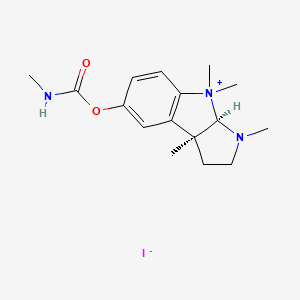
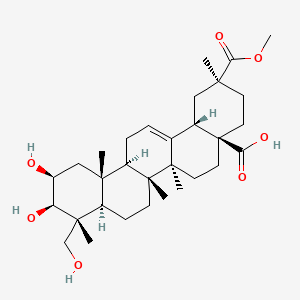
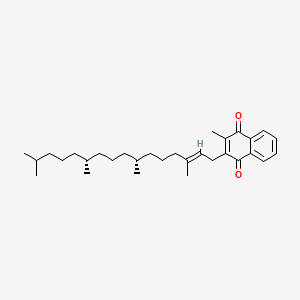
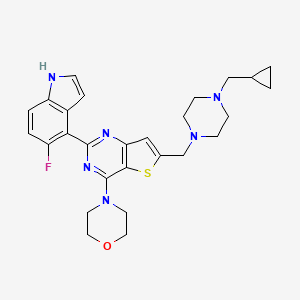
![5-[(E)-3-thiophen-2-ylprop-2-enylidene]-1,3-diazinane-2,4,6-trione](/img/structure/B1677772.png)
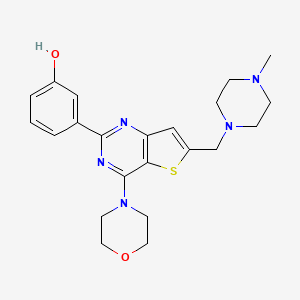
![2-hydroxyethyl 2-hydroxybenzoate-(4as,6as,11br,13bs)-4,4,6a,9-tetramethyl-1,2,3,4,4a,5,6,6a,11b,13b-decahydrobenzo[a]furo[2,3,4-mn]xanthen-11-ol(1:1)](/img/structure/B1677775.png)
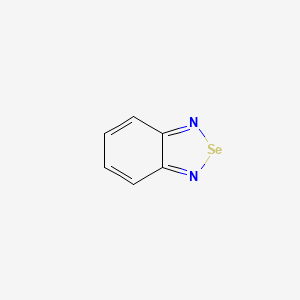
![2-(4-(Methylamino)phenyl)benzo[d]thiazol-6-ol](/img/structure/B1677777.png)

